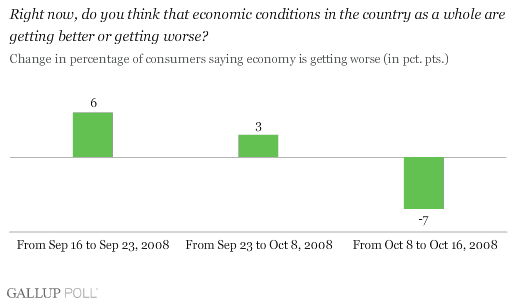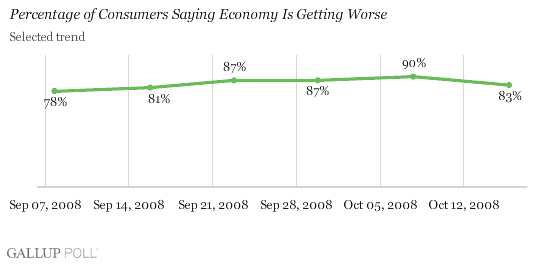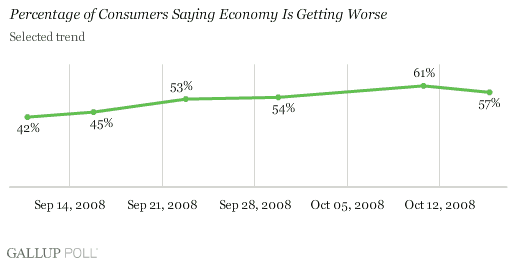PRINCETON, NJ -- Consumer pessimism, although still overwhelmingly high, has declined somewhat in the past several days -- particularly in terms of future economic expectations, with 83% of Americans saying economic conditions are "getting worse" -- down 7 points from last week and only 2 points worse than a month ago.

Percentage Saying Economy Is "Getting Worse" Declines on Margin
Broadly speaking, Gallup's consumer confidence measures show that the financial chaos, Treasury bailout efforts, and plunging stock markets of the past several weeks have caused than they have been previously this year.
However, Americans' economic perceptions are changing much more quickly than in the past -- just like the Wall Street averages, which have undergone such dramatic ups and downs during the past few weeks. Gallup's Daily tracking of consumer confidence suggests that a measure like the Reuters/University of Michigan preliminary Consumer Sentiment Index -- reflecting about 300 interviews conducted over the first couple of weeks this month and showing that consumer sentiment has dropped the most since records began in 1978 -- may already be out of date.
On Oct. 8, 90% of consumers said economic conditions were "getting worse," rather than better -- up 12 points from a month earlier. However, the percentage of consumers holding this view has declined 7 points and stands at 83% as of Oct. 16 -- essentially the same as the 81% of a month ago.

Percentage Rating Economy "Poor" Moderates on the Margin
On Oct. 11, Gallup's Daily tracking showed the percentage of consumers rating the economy "poor" reaching a new peak of 61% -- up 19 points from a month earlier. Since that high point, consumer ratings of the current economy have improved on the margin, declining 4 points to 57% as of Oct. 16 -- still well above the 45% who provided this rating a month ago, but better than the Oct. 11 high.

Commentary
Looking at consumer confidence via monthly comparisons, even with a preliminary interim measure, can easily be misleading. The financial crisis, the dramatic plunge in the stock market, the sharp drop in September retail sales, and the continued debacle in the housing market suggest there is good reason for the average American consumer to be pessimistic about current economic conditions and the future direction of the U.S. economy. So, a monthly comparison showing a sharp drop in consumer sentiment is not surprising.
However, economic events are moving too quickly right now for monthly comparisons. For example, the real question that will determine the future direction of the U.S. economy has to do with whether the concerted efforts by the Congress, the Treasury, and the Federal Reserve Board of Governors over the past couple of weeks are working to reduce consumer pessimism, at least on the margin. And the answer to that question lies in daily measures of consumer confidence that pick up short-term changes.
In sharp contrast to Friday's Reuters/University of Michigan Consumer Sentiment Index, Gallup's daily monitoring of consumer confidence suggests that there has been a recent improvement in the way Americans look at the economy. In turn, this suggests that recent public policy efforts have actually helped moderate consumer pessimism on the margin -- rather than failing to do so, as one might glean from the dismal consumer sentiment report released Friday. At least some Americans seem to recognize that the U.S. banking system, and really the global banking system, is much stronger than it was before the crisis intervention efforts of the past several weeks.
On the other hand, consumer confidence -- like consumer spending and U.S. economic activity -- is likely to remain volatile and probably won't turn around completely in the immediate term. For that matter, consumers will continue to get battered as a more traditional consumer spending- and unemployment-driven recession unfolds in the months ahead. As a result, it is important that everyone recognize the good news when policy efforts actually succeed in mitigating the degree of consumer pessimism, even if it is at the margin.
Survey Methods
���۴�ýis interviewing no fewer than 1,000 U.S. adults nationwide each day during 2008. The economic questions analyzed in this report are asked of a random half-sample of respondents each day. The results reported here are based on combined data of approximately 1,500 interviews for three-day rolling polls conducted between Sept. 14 and Oct. 16, 2008. For results based on these samples, the maximum margin of sampling error is ±3 percentage points.
Interviews are conducted with respondents on land-line telephones (for respondents with a land-line telephone) and cellular phones (for respondents who are cell-phone only).
In addition to sampling error, question wording and practical difficulties in conducting surveys can introduce error or bias into the findings of public opinion polls.
